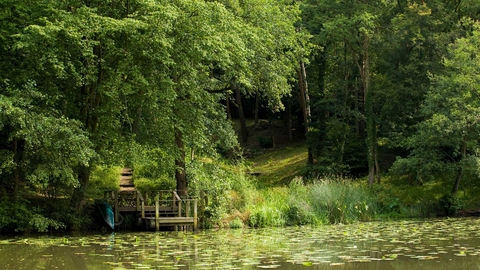NO SWIMMING OR FISHING PERMITTED

© Charlie Hoare
Vann Lake & Candy's Copse
Location
Know before you go
Dogs
When to visit
Opening times
Open at all timesBest time to visit
April to AugustAbout the reserve
Vann Lake is a fine example of ancient woodland on weald clay, surrounding an eight-acre man-made lake that is thought to date from the mid- 18th century, when a forest gill was dammed to form a ‘hammer pond’ to power a mill that was never built.
Walking along the lakeside, you pass through and catch glimpses of several different habitats, including wet and dry woodland and open water. Alder dominates the damp areas and oak the drier parts, with other examples of lime, birch, ash, hazel and beech. Keen eyes may even spot a single mature wild-service tree on the north-west side.
At your feet the flora changes with the geology. There is bramble, honeysuckle and ground ivy on the weald clay, with opposite-leaved golden saxifrage in the damp areas. Woodland plants include spurge laurel, Forster’s wood rush, greater butterfly orchid, violet helleborine, wood anemone and moschatel, or town hall clock. At the lake edge you will find water mint, nodding bur-marigold and marsh marigold, while in the water there is reedmace, common reed and yellow flag, along with white and yellow water-lilies.
However, Vann Lake is best known for fungi. More than 900 species have been recorded here, including six species new to Britain, and Stypella crystallina, a species first identified here. With so many oak trees, the reserve also supports hundreds of invertebrate species, including the purple hairstreak butterfly. Other typical woodland butterflies include the purple emperor, white admiral and silver-washed fritillary.
17 dragonfly and damselfly species include the uncommon downy emerald and shiny emerald. A nationally rare cranefly Molophilus lackschewitzianus occurs along the gill, while the locally rare cranefly Limonia didyma breeds among mosses at the water outflow below the lake.
Around ten species of fish live in the lake, including bream, roach, tench, pike and European eel. More than 100 bird species have been recorded, including kingfishers, marsh tits, lesser spotted woodpeckers and hawfinches.
Please note that Vann Lake is a designated SSSI and recreational fishing or other water-based activities are not permitted.
Accessibility and facilities
- This site does not have a car park. Access on foot at the end of Vann Lake Road, off Weare Street, Ockley. Please do not park on Vann Lake Road.
- There are no accessible self-guided trails at this site.
- Paths are unmade and may be steep, uneven and slippery in places.
- There are no refreshments or toilets on site.
- This site is not suitable for wheelchair and mobility scooter users, or people with serious mobility issues.
